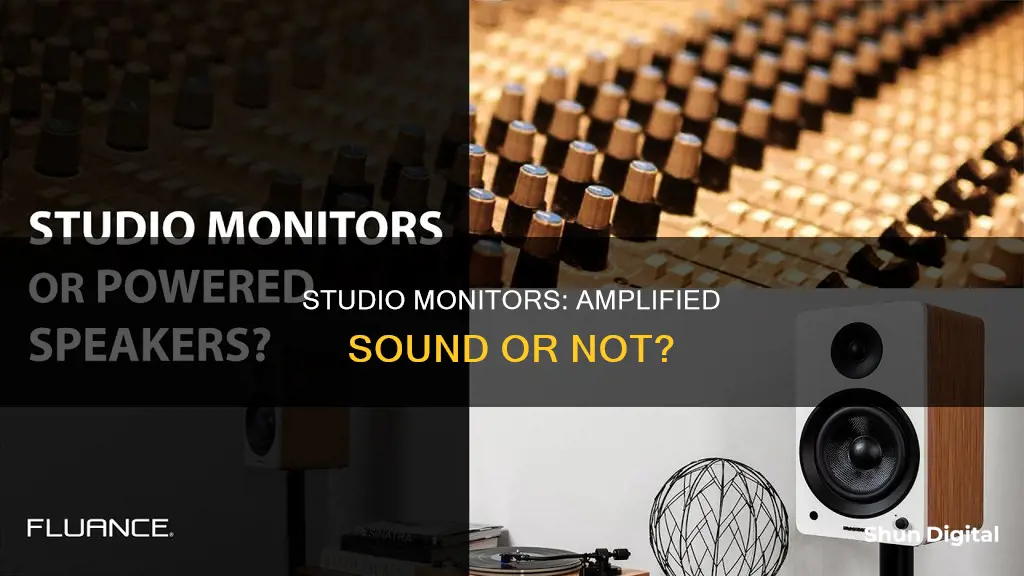
Studio monitors are an essential component of the music production process, delivering accurate and detailed sound reproduction to enable critical mixing decisions. The market offers a variety of studio monitors, including active and passive monitors, with the former being more prevalent today. Active monitors, also known as powered monitors, have built-in amplifiers, while passive monitors require external power amplifiers. The choice between active and passive monitors depends on specific needs and preferences. Active monitors are simpler to use and set up, while passive monitors offer more flexibility in amplifier selection.
The power requirements for passive monitors depend on various factors, including monitor sensitivity, volume preference, listening distance, and room size. A typical power amplifier for passive nearfield monitors in a small studio should provide around 50 watts per channel into an 8-ohm load. This ensures sufficient headroom to handle peak levels and occasional volume increases.
Studio monitors also come in different sizes, typically ranging from 3-inch to 8-inch woofers for nearfield monitors. The size of the woofer impacts the range and clarity of bass and lower midrange frequencies. Additionally, the amplifier configuration varies, with single-amp, bi-amp, and tri-amp options available. Bi-amp and tri-amp configurations provide dedicated amplifier channels for each driver, resulting in improved frequency response and sound reproduction.
When choosing studio monitors, it is essential to consider factors such as size, wattage, and budget. For home studios, 5-inch woofers are commonly recommended. Wattage should be sufficient to deliver adequate sound levels without distortion, typically starting at 50-75 watts per channel for small to medium-sized rooms. In terms of budget, beginners can find decent monitors in the $200-$400 range, while professionals might invest upwards of $1,000 per monitor for high-end options.
| Characteristics | Values |
|---|---|
| Type | Studio monitors can be passive or active. Passive monitors require an external amplifier, while active monitors have built-in amplifiers. |
| Amplification | Studio monitors may be "active" (including one or more internal power amplifiers) or "passive" (requiring an external power amplifier). |
| Drivers | Studio monitors usually have two drivers or speakers: a tweeter and a woofer. Some monitors have a third driver, a mid-range speaker, for a three-way system. |
| Use | Studio monitors are designed for near-field or far-field use. Near-field monitors are compact and placed closer to the listener, while far-field monitors are larger and placed further away. |
| Size | The size of studio monitors varies, with larger monitors having larger woofers and being more suited for bigger studio environments. |
| Configuration | Studio monitors can be configured in different ways, such as near-field, mid-field, or far-field. |
| Purpose | Studio monitors are used for accurate audio reproduction in professional audio production applications, such as recording studios, filmmaking, and broadcasting. |
| Sound | Studio monitors aim to produce a flat (linear) phase and frequency response, with minimal emphasis or de-emphasis of particular frequencies, providing an accurate reproduction of the tonal qualities of the source audio. |
What You'll Learn

Active vs. Passive Monitors
Studio monitors are available in two types: active and passive. Active monitors have built-in amplifiers, while passive monitors require an external amplifier.
Active Monitors
Active monitors are simple to set up and do not require any additional equipment. They are a plug-and-play solution that is reliable and accurate. The built-in amplifiers are designed specifically for the monitors, which can lead to better overall sound quality.
Passive Monitors
Passive monitors offer more flexibility as they allow you to choose an external amplifier that best suits your needs. They are lighter, easier to mount, and only require a standard speaker cable. Passive monitors are also a great choice if you want to customise your signal chain by choosing your own amplifier, crossover system, and other processors.
The choice between active and passive monitors depends on your specific needs and preferences. If you want an easy and straightforward solution, active monitors are the way to go. On the other hand, if you are looking for more flexibility and are willing to put in some extra effort, passive monitors might be a better option.
LCD vs LED Monitors: What's the Main Difference?
You may want to see also

Amplifier Configurations
There are three amplifier configurations to choose from when it comes to studio monitors: single-amp, bi-amp, and tri-amp. Each configuration has its own advantages and is better suited to certain setups.
The single-amp configuration is the simplest of the three, where the left and right speakers are powered by a single amplifier, integrated into one of the speakers. This setup is rarely used for studio monitors but is common for computer speakers.
The bi-amp configuration, on the other hand, is more advanced and offers greater control over the frequency response. In this setup, each speaker has two amplifier modules, and in a 2-way design, each driver has its own dedicated amplifier. This allows for more precise sound reproduction and is often used in professional studios where accuracy and detail are crucial.
The tri-amp configuration is the most advanced and complex of the three. In this setup, each driver in a 3-way speaker (woofer, midrange, and tweeter) has its own dedicated amplifier, providing ultimate control over the frequency response and the most precise sound reproduction. Tri-amp configurations are typically found in high-end professional studios that require the highest level of accuracy.
When choosing an amplifier configuration, it's important to consider the type of studio monitors you have, the level of precision and control you need, and the specific requirements of your studio setup.
Removing Monitor Heater Vent Pipes: A Step-by-Step Guide
You may want to see also

Studio Monitor Size
When choosing the size of studio monitors, there are several factors to consider:
- Low-End Frequency Reproduction: Larger studio monitors can reproduce lower frequencies better than smaller ones. For example, the Yamaha HS5 studio monitors with a 5-inch woofer can reproduce bass frequencies around 54Hz, while the Yamaha HS8, with an 8-inch woofer, can reproduce bass frequencies around 38Hz. If your music has more low-end frequency information, a bigger studio monitor is recommended.
- Room Size and Treatment: The size of the room is crucial for achieving good sound quality. Bigger monitors require larger rooms; otherwise, they may not operate properly and may cause issues like room mode activation, frequency shifts, and phase cancellation. For a room size of about 4x4x2.5 meters, 8-inch monitors are recommended. A room that is 5x5x3 meters in size is perfect for 8-inch monitors. For smaller rooms, 5-inch monitors are suggested.
- Listening Distance: Bigger studio monitors can be placed farther away from the listener and tend to have a wider sweet spot range. They are also louder than smaller monitors. The listening distance should be considered when choosing monitor size, as most near-field studio monitors between 5 and 8 inches can be kept at a listening distance between 0.2 to 3 meters.
- Budget: Smaller studio monitors are typically more affordable than larger ones. If you are on a tight budget, starting with monitors below 5 inches is a good option.
In summary, the size of studio monitors depends on various factors, including the low-end frequency reproduction needs, room size, listening distance, and budget. For small, untreated rooms, monitors below 5 inches are recommended. For acoustically treated rooms, 5- to 8-inch monitors are suitable, depending on the room size and low-end frequency requirements.
Alcohol Ankle Monitors: GPS Tracking for Sobriety Compliance
You may want to see also

Powered Studio Monitors
Some powered studio monitors include simple equalisers and gain controls that allow you to adjust for frequency imbalances in your room. More advanced models include sophisticated DSP (digital signal processing) to compensate for more complex room acoustics.
When choosing powered studio monitors, it's important to consider the size of your room and the distance from the listener's ears. Nearfield monitors are designed to be placed fairly close to the listener, while midfield monitors are placed further away in larger rooms.
Some popular powered studio monitor options include the Yamaha HS5, JBL 305P MKII, and KRK Rokit series.
Tracking Team Performance: A Key to Success
You may want to see also

Passive Studio Monitors
When choosing passive studio monitors, factors such as speaker size, enclosure type, impedance, and maximum peak SPL should be considered. Some popular passive monitor brands include Avantone Pro, Amphion, Auratone, and JBL. For example, the Avantone Pro CLA-10 is an 8-ohm, 2-way passive studio monitor with a 7" woofer and a 1-3/8" soft-dome tweeter. Another option is the Amphion Two15, a passive 2-way studio monitor with dual 5.25" midrange/woofers and 200W power handling.
It's important to note that passive studio monitors may require additional components, such as an external crossover if a subwoofer is added to the setup. They may also have limited low-end extension and flatness of frequency response compared to active monitors due to the lack of built-in DSP and matched driver-wise amps.
Understanding Monitor Resolution: Know Your Display Definition
You may want to see also
Frequently asked questions
Studio monitors are important equipment for music production and mixing, as they provide an accurate reproduction of sound, allowing engineers and producers to make critical decisions during the mixing process.
Studio monitors come in various types, including active and passive monitors, near-field and far-field monitors, and ported and unported monitors. Active monitors have built-in amplifiers, while passive monitors require external amplifiers. Near-field monitors are placed closer to the listener and are typically used in smaller studios. Far-field monitors are larger and are placed further away from the listener, often in bigger studios. Ported monitors have holes called ports that redirect internal air pressure, extending the frequency response and allowing for more low frequencies. Unported monitors, also known as closed monitors, do not have these ports.
Yes, studio monitors require amplification to function properly. Active studio monitors have built-in amplifiers, while passive studio monitors use external amplifiers. The electrical signals from a home studio mixer or audio interface are typically too weak, so amplification is necessary to power the studio monitors effectively.
Studio monitors offer a flat frequency response, meaning they do not colour or enhance the sound. This accuracy ensures that the mix will sound consistent across different playback systems. Studio monitors also provide a detailed listening experience, allowing engineers to identify small problems in the mix, such as pops and clicks. Additionally, studio monitors can reproduce complex audio signals faithfully, ensuring that every note, sample, and vocal is accurately reproduced.
When choosing studio monitors, consider the size of your studio, the type of music you'll be working with, and your budget. For a small studio, compact monitors may be more suitable, while larger studios may require bigger monitors. If you're recording music with deep bass, look for monitors with larger woofers. Familiarity with your monitors is also important, so listen to music you know well through the monitors to understand their characteristics.







